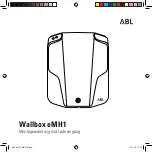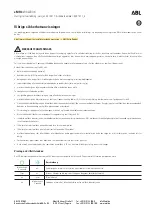
14
D+ dynamo
Connect the charger to the D+ contact of the dynamo as
shown in the diagram.
Connect the cable (brown 0.75 mm²) to the D+ input on the
device and the D+ contact on the dynamo. It is
imperative
that the cable is secured with a 2A fuse (not included in deliv-
ery) close to the dynamo! The fuse serves to protect the cable.
Charging control panel
If you use a charging control panel, connect this to the panel
connection BC (7-pin) on the device.
Temperature sensor
If you use a temperature sensor for the battery II, adhere the
temperature sensor to the face side of the battery II (starter
battery). To do this, remove the protective film from the self-
adhesive point of the temperature sensor and press it firmly
onto the desired position of the battery II (see Temperature
sensor description). Connect the cable from the temperature
sensor to the temperature sensor connection of the device
(2-pin connection).
Battery type changeover switch
Set the battery type (liquid electrolyte or Gel / AGM) of your
battery on the battery switchover.
Main supply connection
Connect the main power cable of your boat, camper or cara-
van. Green / yellow cable to the protective earth!
Check all connections are tight.
Finally, connect to the mains using the 230 V cold device
plug of the power cable.
Wiring diagram
Always install the fuses close to the positive terminal of
the battery!
+
+
_
_
BN 0.75 mm²
40A*
RT 10 mm²
BL 10 mm²
2A*
R
T 10 mm²
R
T 0.75 mm²
BL 10 mm²
40A*
3
1
2
2A
Battery IIB
a
tt
e
ry
I
I
senses
e
n
s
e
AlternatorA
lt
e
rn
a
to
r
B+
B+
D+
D+
F
a
ilure
F
a
il
u
re
Tr
ickle charge
Tr
ic
k
le
c
h
a
rg
e
Absorption chargeA
b
s
o
rp
ti
o
n
c
h
a
rg
e
Signal BCOS
ig
n
a
l
B
C
O
---
-
Bulk chargeB
u
lk
c
h
a
rg
e
neg.n
e
g
.
Panel BC
Panel BC
Battery IIB
a
tt
e
ry
I
I
Battery IB
a
tt
e
ry
I
Battery IB
a
tt
e
ry
I
Battery IIB
a
tt
e
ry
I
I
Te
mp. sensor
Te
m
p
.
s
e
n
s
o
r
battery IIb
a
tt
e
ry
I
I
LiquidL
iq
u
id
Gel/A
GM
G
e
l/
A
G
M
Fig. 3: Wiring diagram
* Fuse included in the delivery. The fuses only serve to protect
the cables.
For cables longer than 3 m, see “Cable lengths and
cross-sections”.
–
–
BL = blue
RT = red
BN = brown
D+
dynamo
Charging control panel (optional)
Temperature sensor of the battery (optional)
Taking into operation
The automatic charger is operational as soon as it is connect-
ed to the mains supply.
Before disconnecting or interrupting the DC voltage connec-
tions, e. g. the charging cable to the battery, the device needs
to be switched off at the mains. Disconnect the mains plug!
Batteries with short circuits may not be charged. There
is a risk of explosion caused by the generated detonat-
ing gas!
Prerequisites
The battery must have a rated voltage of 12 V and a minimum
capacity of 100 Ah. Batteries below this minimum capacity
will not be adequately charged. Batteries with capacities that
are too high will be charged too slowly.
Charging process
The battery is charged automatically. After any mains power
failures, the main charging process is automatically restarted.
The main charging process is stopped when the battery
voltage has reached 14.4 V. At the end of the aftercharging
phase, the charging process switches to trickle charging at a
constant 13.8 V.
Parallel operation
In parallel operation, the current drawn up by electrical equip-
ment should be less than the maximum charging current of
30 A. This is the only way to ensure that the battery is being
charged even though consumers are being supplied.
Mains supply mode on ferries
The main supply voltage on ferries can be prone to heavy fluc-
tuations. Therefore do not connect the device to this voltage.
Generator mode
Please observe the handling instructions in the manufacturer‘s
operating instructions. The generator must satisfy the 230 V
mains power connection values. Only connect the device to
the generator if this runs stably and disconnect the device
from this before you turn it off. The voltage peaks generated in
the start-up and shutdown phases can damage the device.
Summary of Contents for BC 630 IU
Page 55: ...Battery Charger BC 630 IU ...















































